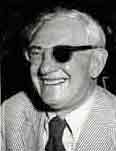Julius Axelrod
(1912 - 2004)

Julius Axelrod was born on May 30, 1912, in New York City. He received his bachelor's degree in biology from the College of the City of New York in 1933. Axelrod wanted to become a physician, but was rejected from every medical school to which he applied. He worked breifly as a laboratory technician at New York University, then, in 1935, he got a job with the New York City Department of Health testing vitamin supplements added to food. He injured his left eye when an ammonia bottle in the lab exploded; he would wear an eyepatch for the rest of his life. While working at the Department of Health, he attended night school and received his Masters of Sciences degree from New York University in 1941.
Analgesic research
In 1946, Axelrod took a position working under Bernard Brodie at Goldwater Memorial Hospital. The research experience and mentorship Axelrod received from Brodie would launch him on his research career. Brodie and Axelrod's research focused on how analgesics (pain-killers) work. During the 1940s, users of non-aspirin analgesics were developing a blood condition known as methemoglobinemia. Axelrod and Brodie discovered that acetanilide, the main ingredient of these pain-killers, was to blame, and recommended replacement with acetaminophen (paracetamol), better known as Tylenol.
Catecholamine research
In 1949, Axelrod began work at the National Heart Institute, part of the National Institutes of Health (NIH). At the National Heart Institute, he worked on the mechanisms and effects of caffeine, which led him to an interest in the sympathetic nervous system and its main neurotransmitters, epinephrine and norepinephrine. During this time, Axelrod also conducted research on codeine, morphine, methamphetamine, and ephedrine, and he also performed some of the first experiments on LSD. Realizing that he could not advance his career without a Ph.D., he took a leave of absence from the NIH in 1954 to attend George Washington University. Allowed to submit some of his previous research toward his degree, he graduated one year later, in 1955. Axelrod then returned to NIH and began some of the key research of his career.
He won a share of the Nobel Prize in Physiology or Medicine in 1970 along with Bernard Katz and Ulf von Euler. Axelrod received the prize for his work on the release, reuptake and storage of the neurotransmitters epinephrine and norepinephrine, also known as adreniline and noradreniline. Working on monoamine oxidase (MAO) inhibitors in 1957, Axelrod showed that catecholamine neurotransmitters do not merely stop working after they are released into the synapse. Instead, neurotransmitters are recaptured (reuptaken) by the pre-synaptic nerve ending, and recycled for later transmissions. He theorized that epinephrine is held in tissues in an inactive form and is liberated by the nervous system when needed. This research laid the groundwork for later selective serotonin reuptake inhibitors (SSRIs), such as Prozac, which block the reuptake of another neurotransmitter, seretonin. Axelrod also discovered and characterized the enzyme catechol-O-methyl transferase which is involved in the breakdown of catecholamines.
Pineal gland research
Axelrod's later research focused on the pineal gland. He and his colleagues showed that melatonin has profound effects on the central nervous system, allowing the pineal gland to act as a biological clock. He proved that melatonin is a converted form of the neurotransmitter serotonin and that the pineal gland regulates the release of serotonin to drive the body's circadian rhythm. He continued to work at the NIH until his retirement in 1984.
Political views
After receiving the Nobel Prize in 1970, Axelrod used his visibility to advocate several science policy issues. In 1973, Richard Nixon created an agency with the specific goal of curing cancer. Axelrod, along with fellow Nobel-laurates Marshall W. Nirenberg and Christian Anfinsen, organized a petition by scientists opposed to the new agency, on the grounds that by focusing solely on cancer, public funding would not be available for research into other, more solvable, medical problems. Axelrod also lent his name to several protests against the imprisonment of scientists in the Soviet Union.
Axelrod died on December 29, 2004.
The following press release from the Royal Swedish Academy of Sciences describes Axelrod's work:
The discoveries which this year's Nobel laureates have made have given us answer to questions of fundamental importance for the understanding of the mechanism underlying the transmission between the nerve cells, i.e. at the so-called synapses, and between the nerve terminals and the so-called effector organs, for instance between the motor nerve fibers and the muscle fibers which they innervate. The transmission between the nerve cells, which radically differs from the mechanisms underlying the impulse transmission in the nerve fibers, is mediated by chemical substances, so-called neurotransmitters, which carry the message from one cell to the other. The three scientists have been working independently of each other, but their discoveries all contribute in solving principal questions concerning the neurotransmitters, their storage, release and inactivation.
Dr. Julius Axelrod's discoveries concern the mechanisms which regulate the formation of this important transmitter in the nerve cells and the mechanisms which are involved in the inactivation of noradrenaline, partly under the influence of an enzyme discovered by himself.
von Euler's and Axelrod's discoveries have not only increased our knowledge about the transmission in the sympathetic nervous system, they also form the basis for the understanding of the transmission in the central nervous system and its pharmacology. Thus in a very significant way, the laureates have presented basic data about the physical and chemical mechanisms of the synaptic transmission and thus given us basic information about how the messages are mediated between nerve cells. Their discoveries concerning these regulatory mechanisms in the nervous system are fundamental in neurophysiology and neuropharmacology and have greatly stimulated the search for remedies against nervous and mental disturbances.
Sources: Picture courtesy of U.S. National Library of Medicine, Wikipedia, Nobelprize.org


